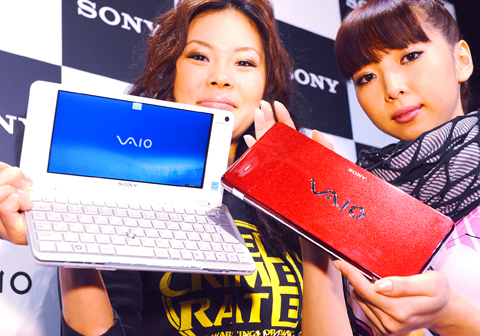Japanese consumer electronics maker Sony Corp yesterday introduced its high-priced alternative to the growing demand for netbooks — the VAIO P — at a product launch held simultaneously in Taipei, Tokyo and Las Vegas’ Consumer Electronics Show.
The VAIO P marks the multinational conglomerate’s foray into pocket PCs, as the company struggles to carve out a market niche to counter the netbook PC attack.
Taipei-based research and consulting group Topology Research Institute (拓墣產業), in a report released yesterday, forecast that global netbook PC shipments would reach between 27.25 million and 32 million this year.

PHOTO: AFP
In response to Topology’s report, Hiroyuki Oda, general manager of Sony Corp’s VAIO business group, told reporters yesterday: “We acknowledge the netbook demand, but we will not enter the low-priced netbook market.”
Oda said that since its founding in 1946, Sony has always been at the forefront of the consumer technology revolution, including the introduction of the concept of music-on-the-go with the launch of the Walkman.
“Our focus has always been on creating value through design, innovation and specialization. Without specialization, there would have been no VAIO,” Oda said.
Oda stressed that the 8-inch VAIO P is a pocket PC — and not a netbook.
However, Taipei-based researcher Market Intelligence Center (MIC) defines netbook PCs as products with display sizes ranging from between 7 inches and 10.2 inches, while notebook PCs are equipped with displays 10.4 inches and above. In short, the VAIO P falls into MIC’s netbook category in terms of display size.
Still, some industry watchers classify netbooks as low cost, mini-notebooks that retail between US$300 and US$400 per unit. The VAIO P series are priced between NT$26,800 and NT$36,800 (US$800 and US$1,100).
Sony is not worried that the VAIO P might cannibalize its existing ultra-portable TT and Z notebook series, since these two lines are even more distinctly priced than the P, with 11-inch and 13-inch displays respectively.
In the near term, the company has no plans of following netbook vendors’ popular tactic of collaborating with local telecom operators to promote their product through bundled sales (netbook + telecom subscription plan), Oda said.
Sony’s new pocket PC, which includes all the latest notebook add-ons, runs on Intel’s Atom Z processor and features an “Instant On” technology that allows users to boot up one program (such as the Internet browser) instead of running the entire operating system.
This same “Instant On” technology, developed by Taiwanese software company Device VM Inc (達維飛碼 ), has attracted a lot of interest at the Consumer Electronics Show in Las Vegas, Topology said.
Netbook vendors such as Asustek Computer Inc (華碩), Acer Inc (宏碁) and Hewlett-Packard Co are embracing this time-saving platform, and rolling out quick-start netbook PCs. Even Lenovo Group Ltd (聯想) recently included “Instant On” in its latest netbook line, Topology said yesterday.
As the economic downturn spreads, global demand for consumer PCs is also slowing. Oda yesterday did not talk about sales forecasts for the VAIO P, saying Sony was still observing consumer response to the new product.
“Although the global financial crisis is hurting sales worldwide, Asia Pacific remains a strong area of growth for us, whereas developed countries such as US, Europe, and Japan are showing signs of a slowdown,” Oda said.

Intel Corp chief executive officer Lip-Bu Tan (陳立武) is expected to meet with Taiwanese suppliers next month in conjunction with the opening of the Computex Taipei trade show, supply chain sources said on Monday. The visit, the first for Tan to Taiwan since assuming his new post last month, would be aimed at enhancing Intel’s ties with suppliers in Taiwan as he attempts to help turn around the struggling US chipmaker, the sources said. Tan is to hold a banquet to celebrate Intel’s 40-year presence in Taiwan before Computex opens on May 20 and invite dozens of Taiwanese suppliers to exchange views

Application-specific integrated circuit designer Faraday Technology Corp (智原) yesterday said that although revenue this quarter would decline 30 percent from last quarter, it retained its full-year forecast of revenue growth of 100 percent. The company attributed the quarterly drop to a slowdown in customers’ production of chips using Faraday’s advanced packaging technology. The company is still confident about its revenue growth this year, given its strong “design-win” — or the projects it won to help customers design their chips, Faraday president Steve Wang (王國雍) told an online earnings conference. “The design-win this year is better than we expected. We believe we will win

Chizuko Kimura has become the first female sushi chef in the world to win a Michelin star, fulfilling a promise she made to her dying husband to continue his legacy. The 54-year-old Japanese chef regained the Michelin star her late husband, Shunei Kimura, won three years ago for their Sushi Shunei restaurant in Paris. For Shunei Kimura, the star was a dream come true. However, the joy was short-lived. He died from cancer just three months later in June 2022. He was 65. The following year, the restaurant in the heart of Montmartre lost its star rating. Chizuko Kimura insisted that the new star is still down

While China’s leaders use their economic and political might to fight US President Donald Trump’s trade war “to the end,” its army of social media soldiers are embarking on a more humorous campaign online. Trump’s tariff blitz has seen Washington and Beijing impose eye-watering duties on imports from the other, fanning a standoff between the economic superpowers that has sparked global recession fears and sent markets into a tailspin. Trump says his policy is a response to years of being “ripped off” by other countries and aims to bring manufacturing to the US, forcing companies to employ US workers. However, China’s online warriors